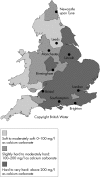Acanthamoeba keratitis in England and Wales: incidence, outcome, and risk factors
- PMID: 11973250
- PMCID: PMC1771120
- DOI: 10.1136/bjo.86.5.536
Acanthamoeba keratitis in England and Wales: incidence, outcome, and risk factors
Abstract
Aim: To determine the incidence, regional variation in frequency, outcome, and risk factors for acanthamoeba keratitis (AK) in England and Wales.
Methods: AK cases presenting from 1 October 1997 to 30 September 1999 were identified by the British Ophthalmic Surveillance Unit active reporting system. Clinical and patient postal questionnaire data were analysed.
Results: 106 reported cases met study criteria. The annual incidence for the 2 years was 1.26 and 1.13 per million adults and, for contact lens (CL) wearers, 21.14 and 17.53 per million. There was marked regional variation in incidence (0 to 85.13 per million adult CL wearers), with CL wearers in the south having a ninefold increased risk of AK compared with those resident in the north (95% confidence limits: 2.2-38.9, p<0.0001), and a threefold increased risk with hard as opposed to soft domestic water (95% confidence limits: 1.73 to 6.58, p<0.001). Treatment and outcome data were similar to those previously reported. 93/106 (88%) patients were CL wearers. Among these, 46/77 (60%) were disinfecting irregularly, and 20/63 (32%) had been swimming in CLs. One step hydrogen peroxide and chlorine release soft CL (SCL) disinfection systems were significantly over-represented among the cases. Among SCL users, one or more previously established risk factors for AK were identified in 50/55 (91%) patients.
Conclusions: The incidence was considerably higher than most previous estimates, and was static. The geographical variation in incidence may be partly related to the increase in risk associated with hard water. The fact that water quality can have such an effect on the risk of AK suggests that many CL wearers must be letting tapwater come into contact with their lenses or storage cases. Improved education for CL wearers and practitioners about hygiene practice and the variable efficacy of contact lens systems could be expected to reduce the incidence of this disease.
Figures
Comment in
-
Acanthamoeba keratitis.Br J Ophthalmol. 2003 Apr;87(4):516-7. doi: 10.1136/bjo.87.4.516. Br J Ophthalmol. 2003. PMID: 12642336 Free PMC article. No abstract available.
References
-
- Duguid IGM, Morlet N, Allan BDS, et al. Outcome of Acanthamoeba keratitis treated with polyhexamethyl biguanide and propamidine. Ophthalmology 1997;104:1587–92. - PubMed
-
- Stehr-Green JK, Bailey TM, Visvesvara GS. The epidemiology of Acanthamoeba keratitis in the United States. Am J Ophthalmol 1989;107:331–6. - PubMed
-
- Stehr-Green JK, Bailey TM, Brandt FH, et al. Acanthamoeba keratitis in soft contact lens wearers: a case-control study. JAMA 1987;258:57–60. - PubMed
-
- Bacon AS, Frazer DG, Dart JKG, et al. A review of 72 cases of Acanthamoeba keratitis 1984–1992. Eye 1993;7:719–25. - PubMed
MeSH terms
Substances
LinkOut - more resources
Full Text Sources
Other Literature Sources
Research Materials
Miscellaneous

